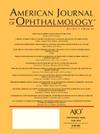Efficacy and safety of biologics in pediatric non-infectious retinal vasculitis.
IF 4.1
1区 医学
Q1 OPHTHALMOLOGY
引用次数: 0
Abstract
PURPOSE To assess the efficacy and safety of adalimumab (ADA) injections (Group 1), infliximab (IFX) (Group 2), and tocilizumab (TCZ) (Group 3) infusions in pediatric non-infectious retinal vasculitis (RV). DESIGN Retrospective interventional case series. METHODS Pediatric patients who were diagnosed with non-infectious RV and treated with biologics (ADA, IFX, TCZ) for ≥6 months were included. Chart review of 11 patients (18 eyes), 17 patients (30 eyes), and 7 patients (11 eyes) in Group 1, 2 and 3, respectively, was performed to assess clinical characteristics, central subfield thickness (CST), and fluorescein angiography (FA) score using the Angiographic Scoring for the Uveitis Working Group (ASUWOG) system. RESULTS Mean age was 13.5±4.3 years in Group 1, 11.8±2.5 years in Group 2, and 13.9±4.1 years in Group 3 (p=0.332). Eight patients (72.7%, 13 eyes) in Group 1, and 14 patients (82.4%, 24 eyes) in Group 2 were biologic-naïve, whereas in Group 3 all patients were treated with ADA and/or IFX prior to TCZ. Mean FA scores were significantly reduced from 6.8±2.6, 13.4±4.8, and 12.8±4.0 at baseline to 0.9±2.3, 3.6±4.6, and 4.4±3.9 at final visit in Group 1, 2, and 3, respectively (p<0.05). Complete RV resolution was observed in 12 (66.7%), 13 (43.3%), and 1 (9.1%) eyes; mean time to complete resolution was 11.0±5.0, 13.3±5.8, and 23 months in Group 1, 2, and 3, respectively. No significant adverse events were observed in any group, except hair loss in one patient which led to discontinuation of IFX infusions after 20 cycles of therapy. CONCLUSION ADA, IFZ, and TCZ are effective and safe treatment options for pediatric non-infectious RV as objectively shown by FA scoring. TCZ appears as an effective therapy for patients with JIA-associated RV or those who failed TNF-α inhibitors.生物制剂治疗儿童非感染性视网膜血管炎的疗效和安全性。
目的评价阿达木单抗(ADA)注射(1组)、英夫利昔单抗(IFX)(2组)和托珠单抗(TCZ)(3组)治疗儿童非感染性视网膜血管炎(RV)的疗效和安全性。设计回顾性介入病例系列。方法纳入诊断为非感染性RV并接受生物制剂(ADA、IFX、TCZ)治疗≥6个月的儿科患者。采用葡萄膜炎工作组(ASUWOG)血管造影评分系统,分别对1、2、3组的11例(18眼)、17例(30眼)和7例(11眼)患者进行图表回顾,评估临床特征、中心亚场厚度(CST)和荧光素血管造影(FA)评分。结果1组患者平均年龄13.5±4.3岁,2组患者平均年龄11.8±2.5岁,3组患者平均年龄13.9±4.1岁(p=0.332)。1组8例患者(72.7%,13只眼),2组14例患者(82.4%,24只眼)biologic-naïve,而3组所有患者在TCZ之前均接受了ADA和/或IFX治疗。1组、2组和3组的平均FA评分分别从基线时的6.8±2.6、13.4±4.8和12.8±4.0降至末次就诊时的0.9±2.3、3.6±4.6和4.4±3.9 (p<0.05)。12只眼(66.7%)、13只眼(43.3%)和1只眼(9.1%)的RV完全消退;1组、2组和3组平均完成缓解时间分别为11.0±5.0、13.3±5.8和23个月。除一名患者脱发导致IFX输注在治疗20个周期后停止外,任何组均未观察到明显的不良事件。结论FA评分客观显示ada、IFZ和TCZ是儿童非感染性RV有效、安全的治疗方案。TCZ似乎是jia相关性RV患者或TNF-α抑制剂无效患者的有效治疗方法。
本文章由计算机程序翻译,如有差异,请以英文原文为准。
求助全文
约1分钟内获得全文
求助全文
来源期刊
CiteScore
9.20
自引率
7.10%
发文量
406
审稿时长
36 days
期刊介绍:
The American Journal of Ophthalmology is a peer-reviewed, scientific publication that welcomes the submission of original, previously unpublished manuscripts directed to ophthalmologists and visual science specialists describing clinical investigations, clinical observations, and clinically relevant laboratory investigations. Published monthly since 1884, the full text of the American Journal of Ophthalmology and supplementary material are also presented online at www.AJO.com and on ScienceDirect.
The American Journal of Ophthalmology publishes Full-Length Articles, Perspectives, Editorials, Correspondences, Books Reports and Announcements. Brief Reports and Case Reports are no longer published. We recommend submitting Brief Reports and Case Reports to our companion publication, the American Journal of Ophthalmology Case Reports.
Manuscripts are accepted with the understanding that they have not been and will not be published elsewhere substantially in any format, and that there are no ethical problems with the content or data collection. Authors may be requested to produce the data upon which the manuscript is based and to answer expeditiously any questions about the manuscript or its authors.

 求助内容:
求助内容: 应助结果提醒方式:
应助结果提醒方式:


